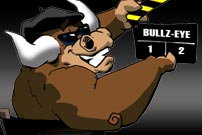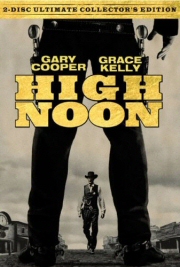 With the temperature dropping, it's time to find someone to keep you warm. Find your hookups with our online dating guide!
With the temperature dropping, it's time to find someone to keep you warm. Find your hookups with our online dating guide!
- Rated NR
- Drama
- 1952
- Buy the DVD
Reviewed by Bob Westal
()
masterfully efficient thriller and the single most parodied Western of all time, “High Noon” is also one of the most controversial. In its day it was attacked as leftist propaganda – its premise was, and is, widely seen as a metaphor for the McCarthy era. Writer Carl Foreman was called in as a hostile witness to the House Un-American Activities Committee (HUAC) during the production, and later blacklisted. Also, its use of black and white photography and claustrophobic, noirish realism at a time when even low budget westerns were being made in eye-filling color, worried studio suits who wanted lots of puffy clouds and wide open spaces. While the film finally became a huge, Oscar-winning hit and a widely acknowledged classic, the critical attacks have never ended. It has been slammed for decades by some of the world’s most respected critics as a stodgy, one-dimensional “message picture.” Howard Hawks, one of the two or three greatest western directors of all time, famously slammed it for what he saw as the unprofessional behavior of its hero. I respectfully disagree with all of them.
For all the complexity and controversy, the actual story of “High Noon” is ingeniously simple: lawman Will Kane (a 50-something Gary Cooper) has retired to marry Amy (a then-unknown Grace Kelly), a beautiful young woman and a convert to the pacifist Quaker faith. Just as the couple is wed and ready to embark on a new life together, somewhere out on the prairie, word arrives that a vicious outlaw who once controlled the town has been suddenly pardoned and will be returning. He and three henchmen mean to murder Kane. His train will arrive (well, you know when) and it’s a quarter to 11. Though Kane and his strong-willed, violence-loathing, bride initially flee, he decides that he must face the half-insane killer or continue running forever. Though the decision threatens his new marriage, he refuses to reconsider.
Worse, Amy isn’t the only person who disagrees. One by one, his old allies refuse to help him, each for their own reasons. Even his callow, selfish deputy (Lloyd Bridges) -- who has taken up with Kane’s former flame, a Mexican saloon owner (Katy Jurado) -- abandons him when Kane turns him down for an unethical promotion in return for his help. Others abandon him out of fear, concern for business, and perhaps even good sense. Of course, it all ultimately comes together in probably the single most famous gunfight in movie history.
With little action until its oft-copied finale, “High Noon” works for any number of reasons. The real-time “gimmick” is actually a canny use of an ancient device that really does amplify the suspense. More important, Carl Foreman’s brilliant screenplay pays due respect to each character, no matter how sad or loathsome.
Among the characters caught in the middle, by far the most fascinating and complex is Katy Jurado as Kane’s conflicted ex. In the kind of performance precious few nonwhites were allowed to give in classic era Hollywood, she is allowed to portray a successful businesswoman operating in the deeply prejudiced old West. She may still love Will Kane, but while she encourages the strong-willed Amy to abandon her pacifist principles in defense of Kane’s life, she won’t risk being beaten, raped and possibly murdered to stay in town (she is also the ex-lover of the all but faceless returning killer) – Kane is no longer “her man” to save.
One common definition of a “classic” work is that, every time you return to it, something new is visible. This time, as a fan of Howard Hawks’ 1959 “answer film,” “Rio Bravo,” I came in hyper-aware of Hawks’ attack on Will Kane’s tactics, even his manliness. But, watching “High Noon” now, the criticism seems more off base than ever. For one thing, contrary to Hawks’ position, Kane is trying to recruit help not from terrified civilians, but experienced members of a posse he had formerly used to free the town of Miller’s influence. Also – and this is something most of the film’s biggest fans won’t agree with – it’s entirely possible that Kane is not making the correct decision. Perhaps he and the town really would be safer trying to avoid the fight – a new marshal is set to arrive the following day and, for all we know, he’s even better with a gun than Will Kane. In any case, you don’t have to be sure he’s taking the smartest course to sympathize with his plight or his reasoning.
Like “Casablanca,” “High Noon” is a highly collaborative film -- not an instance where you can easily point to the director, or even its talented writer or strong producer, as the main creative force. Still, director Fred Zinneman deserves more credit than he usually gets. His sensitive work allows Kane to seem more panicked and even hysterical than a more simplistic director might have allowed. His use of stark imagery, such as the famous repeated shot of the train tracks, amplifies the tension and conflicted emotions. The Austrian-born director should also get credit for the astonishing work of the large ensemble cast that includes a variety of character actors – great, mediocre and in between – all doing some of their very best work.
And then there’s the music by Dimitri Tiomkin. Title songs were not that common in 1952, but the starkly unforgettable “Do Not Forsake Me Oh My Darling” (lyrics by Ned Washington and supposedly partially lifted from an old Russian melody) became a huge hit, won an Oscar, and made theme songs standard practice in films for years to come, and all but mandatory in Westerns. But it’s Tiomkin’s innovative, stark underscoring that adds a new level of feeling to Carl Foreman’s writing and Fred Zinnemann’s interpretation.
I could go on – I’ve barely touched on the work of cinematographer Floyd Crosby here or the key role of producer Stanley Kramer -- but it’s all in the way the elements come together. It’s really not that “High Noon” is the best Western ever made. I don’t think it is. It’s just that, for the story its makers were trying to tell, the result was that the best movie it could possibly have been.
Two-Disc Ultimate Collector's Edition DVD Review:
Released just a few years after a prior version, Lionsgate is definitely open to charges of “double dipping” here. However, I’ll give them a pass because, despite some flaws -- including the bizarre use of generic “dramatic” music on the DVD menu rather than a passage from Dimitri Tiomkin’s iconic score -- this is a strong package that shows the political rough edges of the film all these years later. Though I haven’t seen the prior DVD, the visual quality of the restoration here is absolutely first-rate. I’ve never seen “High Noon” look better.
The 2002 commentary track features the children of some of the main figures in the “High Noon” saga, including Tim Zinneman, Maria Cooper and Jonathan Foreman, a writer for conservative newspapers in the U.S. and Britain. Also on hand is the late actor John Ritter – yes, that John Ritter – speaking for his father, movie cowboy and country music legend Tex Ritter, who sang “Do Not Forsake Me Oh My Darling.” Cooper and Foreman do most of the talking and kind of suck the air out the discussion at times with their extremely simplistic reading of the film, but a couple of political remarks are interesting and remind us how much has changed in six years. (It might have been a more lively discussion if, say, Beau or Jeff Bridges was there to speak for their late diehard liberal dad, Lloyd Bridges, or if the son of cinematographer Floyd Crosby were on hand. That would be musician David Crosby -- yes, that David Crosby.)
You can follow us on Twitter and Facebook for content updates. Also, sign up for our email list for weekly updates and check us out on Google+ as well.











